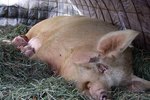Rectal prolapse, or a protruding rectum, is more common in pigs than in other farm animals. Prolapse occurs when there is pressure on the abdomen and the pelvic muscles are not strong enough to hold the rectum in place. It may occur in individual pigs or as an outbreak affecting many pigs in the herd.
Causes and Prevention
Some common causes of rectal prolapse in pigs include:
- Cold stress when pigs pile together for warmth and putting pressure on the abdomen
- Transport stress when pigs are piled together in a trailer
- Severe coughing
- Straining due to constipation
- Intestinal inflammation, which can be caused by infections such as salmonellosis or ascariasis
- Diarrhea caused by conditions such as swine fever
- Antibiotics such as Tylosin and Lincocin that may cause intestinal swelling
Pig owners can prevent rectal prolapse by minimizing the factors that cause the condition. For example, ensuring that pigs have warm shelter to prevent cold stress and ensuring they have adequate food and water to prevent constipation. Avoid diets that contain whey, brewer’s grains or insufficient fiber. Monitoring pigs and immediately addressing illnesses can further help prevent prolapse.
Prolapse Treatment Options
Treatment of rectal prolapse depends on the severity of the prolapse. In some cases, the rectum quickly returns to its correct position inside of the anus. If there was no damage to the rectum, the pig usually recovers with no long-term consequences.
Warnings
If your pig has a prolapsed rectum, isolate him immediately. The protruding material is easily damaged on fencing and feeders. Isolation prevents other pigs from chewing on or eating the prolapsed material.
If the prolapsed rectum remains outside of the anus, it swells. If there is no damage to the intestine, your vet can sprinkle salt or sugar on the prolapsed material. After approximately 30 minutes, the swelling should decrease and your vet can push the intestine back inside of the anus. A suture may be required in the anus to keep the rectum in place.
If the prolapsed rectum is damaged, your vet will amputate the prolapsed material by inserting a pipe into the rectum and tying the prolapse to cut off the blood supply. The prolapse will dry out and fall off in approximately one week.
Tips
In all cases of rectal prolapse, your pig should receive antibiotic treatment to prevent or treat infection.
Long-Term Effects of Rectal Prolapse
If the rectal prolapse is successfully treated with no damage to the rectum, pigs may recover fully with no ill effects. However, if there is damage to the rectum, the prolapsed material may slowly die off and cause secondary infections.
The pig may develop rectal stricture, a condition that occurs when scar tissue develops in the prolapsed material and eventually blocks the rectum. This condition is fatal and pigs must be euthanized.
Writer Bio
Maureen Malone started writing in 2008. She writes articles for business promotion and informational articles on various websites. Malone has a Bachelor of Science in technical management with an emphasis in biology from DeVry University.




